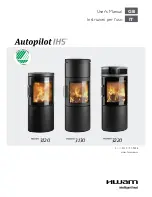
24
Installation into a Masonry Fireplace:
1. Your chimney must be inspected by a certi
fi
ed chim-
ney sweep or installer to determine its structural
condition.
2. Measure amount of venting required to top chimney
plus 14”
to ensure the termination is adequate
distance above the roo
fl
ine.
3. The
fi
rst 5’ of exhaust will be Simpson Dura Vent
pellet stove
fl
ex vent; the remainder uses rigid pipe.
For each joint subtract 1-1/2” to allow for the over-
lap. You may need an adjustable length section to
achieve the correct height. The air intake may be 2”
aluminum
fl
ex vent.
4. Assemble the
fi
rst rigid section of exhaust pipe
to the
fl
ex vent pipe insuring that the “UP” arrows
shown on the pipe labels are pointing up. Connect
sections and twist to lock. Repeat the process for
the remainder of the pipe sections and lower the as-
sembly down the chimney. Lower the intake and
exhaust pipes below their normal position to con-
nect the pipe to back of heater. Tie a line to the top
section of venting to pull it back up to the correct
position.
5. Connect to the exhaust of the stove by installing a
pipe adapter to the exhaust fan and either a 90º el-
bow or a clean out tee with cap. The air intake can
be attached to the heater with a hose clamp.
6. Connect the heater to the coupling on the bottom of
the exhaust
fl
ex vent and twist to the locked posi-
tion. Push the heater into the
fi
replace to its
fi
nal
position.
7. From the top of the chimney, pull the vent system up
to the desired height.
8. For the exhaust termination of the pellet vent use a
tall cone
fl
ashing and a storm collar. This requires
14” of pipe above the top of the masonry chimney.
Pull the pipe up through the
fl
ashing to the desired
height and mark where the storm collar will go. Slip
the storm collar down over the pipe and fasten it
to the pipe with a 1/4” stainless steel sheet metal
screw. The storm collar will then support the entire
exhaust vent system.
9. Install the air intake vent through the chimney cap
by cutting a hole and install cap as shown or attach
air intake vent to a
fl
ashing and cap. The chimney
top must be properly sealed to prevent rain and or
snow from entering the chimney.
10. Install the cap and seal around the joint of the storm
collar and any other joints that are visible.
Perform these instructions in reverse if the removal of
this appliance is ever needed for maintenance or repair.
Air Inlet
Exhaust Cap
Steel Plate or Flashing
Rigid Vent Pipe
Damper Removed or
Fastened Open
(for Canada) or sealed
Flexible Exhaust
Vent
Mantle
90º Elbow or Clean-Out Tee
Minimum 6” (150 mm)non-
combustible Floor Protection













































